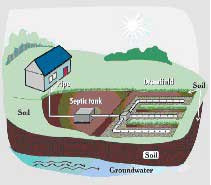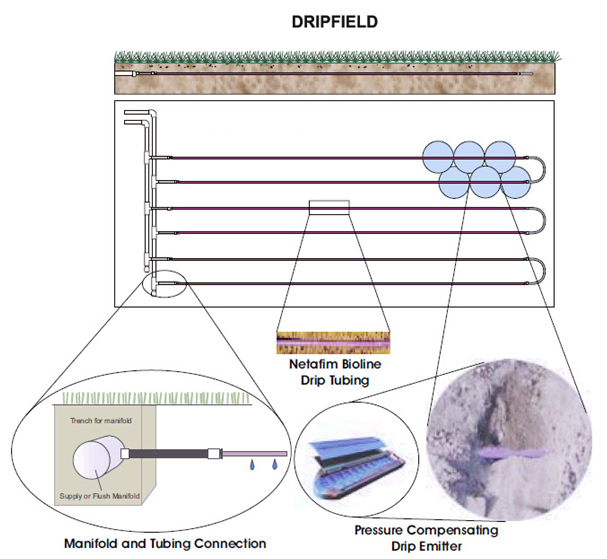Septic Systems
A septic tank is the first component of a septic system which is an onsite sewage treatment and disposal system. The second component is the drainfield where sewage is “disposed” of in the soil. These systems serve those sites without connections to municipal sewage treatment plants. A septic system can be a conventional septic system, a low pressure pipe septic system, aerobic treatment septic system, nitrogen reducing septic system, nutrient reducing septic system or a performance base treatment system.
Conventional Septic Tank-Drainfield System
A conventional septic system consists primarily of two components, the septic tank and the drainfield. The septic tank provides some treatment to the wastewater while retaining the solids. Distribution/disposal of the wastewater occurs in the drainfield. Drainfield materials can be rock/pipe, chambers or multi-pipe. Each of these materials allows the effluent to be dispersed in the soil where final treatment occurs.
A conventional system is installed below the ground surface where the soil/groundwater conditions are good. These systems are usually gravity fed (no pumps required) due to the depth of installation.
A mound system is required when soil or groundwater conditions are as such that a “below grade” drainfield cannot be installed. This type of system typically requires a pump as the drainfield is higher than the outlet of the septic tank. A raised or mound system is required in areas where an elevated groundwater table is present.
A mound system produces an unsightly “hump” and can occupy a significant amount of space because of shoulder and sideslope requirements. A 4-foot shoulder is required around the drainfield and then the sideslope. The shoulder and sideslope can add 18 feet or more to the total length and width of the area occupied by the drainfield. Aerobic treatment-ATU-drip irrigation systems can be installed in place of the conventional system. In doing so, the mound height is reduced by a minimum of 12-15 inches and the overall footprint is reduced by about 50%. Best of all, aerobic treatment-ATU-drip irrigation systems can be installed at the same cost as the conventional mound: USUALLY LESS because they require significantly less fill. In addition, certain soil conditions are not required to be removed or excavated when using an aerobic treatment-ATU-drip irrigation system. This further reduces the cost of the system.
Low Pressure Pipe-LPP-Septic Systems
A low pressure pipe system is required when the drainfield square-footage exceeds 1000 square feet. This system is set up with PVC pipe inside the conventional drainfield to distribute the effluent evenly throughout the entire absorption area. This system requires a pump and can be installed below or above ground. Aerobic treatment (ATU)/drip irrigation systems can be installed in place of the LPP and is almost always less expensive.
Aerobic Treatment-ATU-Drip Irrigation Systems
Aerobic treatment-ATU-drip irrigation systems TREAT the wastewater prior to disposal. There are two types of aerobic treatment systems: extended aeration and fixed-film. The treatment units that we utilize in our designs produce effluent that is virtually odorless and colorless (depending on the treatment unit product). This system replaces the conventional drainfield product with a ½ inch diameter subsurface drip irrigation (drip dispersal) line similar to drip products used in landscaping. The treatment train consists of a trash tank, treatment unit (aeration chamber & clarifier) and dose tank. Some units are available in an “all-in-one” configuration in one tank.
Click here to view a functioning dripfield >>
Benefits
- Effectively recycles all water consumed within a home or business.
- Wastewater is treated prior to dispersal. No real treatment occurs in the soil so no biomat develops.
- Effluent is slowly and uniformly distributed over a 24 hour period. Only a “wetting” of the soil occurs. Soil has time between doses to dry out.
- Drainfield reductions (up to 40%) can be applied.
- System occupies a smaller footprint especially when a mound is required.
- Environmentally friendly.
Advantages
- The dripfield can be installed in landscape areas. Plants are completely irrigated with your wastewater.
- Drainfield reduction allows larger homes to be built on smaller lots.
- Reduced setbacks to property lines, foundations and surface water.
- Dripline can be installed in areas where the conventional just won’t fit.
- Tremendous flexibility in the way the dripfield is installed (not bound to a “rectangular” footprint).
- Significant reduction in mound height/overall footprint; REDUCES COST!
- Excavations can be eliminated; REDUCES COST!
- Eliminate future repairs. Once installed, virtually a lifetime system. Pays for itself.
- In a mounded scenario, less expensive than a conventional system. THE BETTER SYSTEM ACTUALLY COSTS LESS!
- Can tabulate unobstructed area wherever dripline can be installed.
- The larger the system, the more cost effective it becomes.
- Dripline can be installed following contours of property (conventional must be installed level).
- Environmentally friendly.
Some products are perfectly suited for the residential market while others are capable of providing excellent treatment for higher flows- such as commercial sites. A specific treatment level may be required to overcome certain site restrictions or to meet code requirements. Our thorough knowledge of the various aerobic treatment-ATU-drip irrigation products allows us to provide designs that are site/project specific and budget friendly.
Click on the products below for more information about each.








